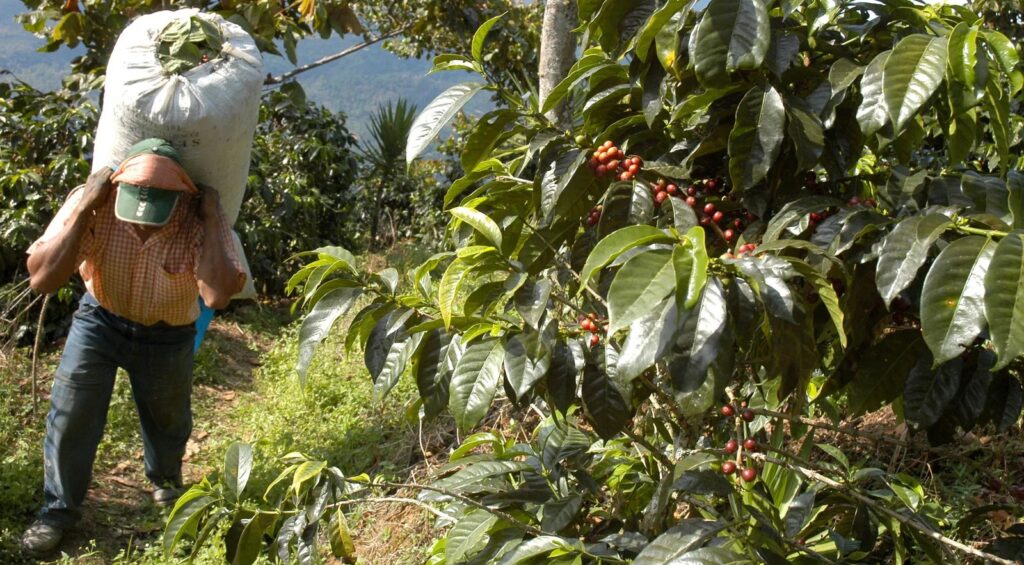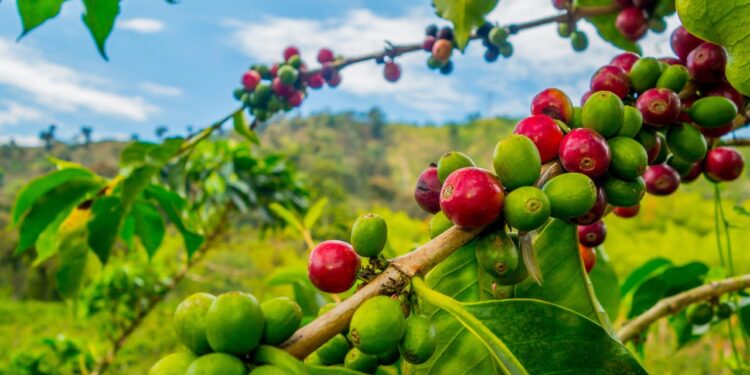Coffee has never been more popular, yet never more uncertain. As global production faces environmental pressures and geopolitical shifts, prices are soaring and consumption is evolving. With climate instability threatening traditional growing regions, and demand rising in both developed and emerging markets, coffee is rapidly becoming a bellwether for the economic and ecological challenges of the decade.
The global landscape of coffee production
More than 70 countries grow coffee, but the global supply depends heavily on a few dominant producers. Brazil remains the world’s largest exporter, responsible for roughly 38 per cent of global output. Its position is particularly strong in the production of Arabica beans, prized for their smoother flavour and used predominantly in premium blends. However, in 2024, Brazil’s coffee industry was once again rattled by extreme weather, including a protracted drought followed by intense frost in key growing regions.
Vietnam, the second-largest producer, focuses largely on Robusta beans, known for their stronger, more bitter profile and higher caffeine content. Together, Brazil and Vietnam supply more than half of the world’s coffee, followed by Colombia, Indonesia, and Ethiopia. Across Africa, countries such as Uganda and Kenya contribute niche varieties, while Central America continues to provide high-altitude Arabicas to the speciality market.
Production, however, is becoming increasingly volatile. According to agricultural forecasts, global output for the 2024–25 season is estimated at 172 million 60-kg bags. This is a mild recovery from previous declines, but still fragile. Poor rainfall, soil degradation, deforestation, and rising temperatures all limit yields. The Intergovernmental Panel on Climate Change projects that half ofthe current coffee-producing land may become unsuitable by 2050 if warming trends continue.

Rising costs and the economics of your cup
In cafés across London, Sydney, and New York, the price of a regular cup of coffee has climbed steadily over the past two years. Average retail prices have increased by 20 to 40 per cent, depending onthe region. In Australia, coffee now routinely costs over AUD $6–7 per cup. In the US and Europe, price hikes have followed spikes in wholesale prices, driven by raw bean shortages and increased import costs.
Arabica futures soared to over $4.30 per pound in early 2025, nearly doubling in less than a year. Robusta beans, once a cheaper alternative, have also reached historical highs due to production shortfalls in Vietnam and Indonesia. For many roasters and distributors, these conditions represent the most unstable pricing environment in decades.
But the increase is not only about the weather. Labour costs in producing nations have risen, with many farmers demanding fairer pay amidst rising living costs. Smallholders, who account for over 80 per cent of global coffee production, often receive less than five per cent of the retail value. Meanwhile, export tariffs — particularly those implemented in trade disputes between the US and major suppliers like Brazil — have added additional layers of expense.
In packaging, transportation and energy, inflation has played a decisive role. Disrupted shipping lanes, fuel cost inflation, and logistics bottlenecks have driven up operating expenses throughout the supply chain. Some coffee houses have absorbed part of the cost, but many have passed it on to consumers.
Climate change as a structural threat
What was once considered seasonal variability in coffee production is now widely recognised as climate-induced instability. Changing rainfall patterns, prolonged droughts, and erratic temperature fluctuations reduce the reliability of harvests. Diseases like coffee rust, intensified by warm and humid conditions, are spreading into previously unaffected areas.
In Brazil, for instance, the 2023–24 season saw a near 35 per cent reduction in Arabica yields from peak levels. In Vietnam, unusually dry conditions during the flowering stages cut Robusta yields by more than 20 per cent. These shocks compound the uncertainty faced by smallholder farmers, many of whom lack the resources to adapt with irrigation or replanting.
Efforts are underway to introduce climate-resilient coffee varieties and more sustainable farming practices, but uptake remains patchy. Certification schemes such as Fairtrade and Rainforest Alliance have promoted better environmental stewardship, but questions remain about how effectively the global coffee trade supports growers in real terms.
Changing global demand and new consumer habits
While production faces headwinds, demand for coffee continues to climb. Global consumption is projected to exceed 170 million bags in 2025, with growth especially strong in Asia and the Middle East. China, once a nation of tea drinkers, is emerging as one of the fastest-growing markets for coffee consumption, driven by urbanisation and a burgeoning café culture.
In Europe and North America, consumption has stabilised at high levels. Scandinavian countries, in particular, maintain some of the highest per-capita consumption rates in the world. Finland leads the global rankings, with an average citizen consuming nearly four cups per day.
Top 10 countries by per-capita coffee consumption (2024)
- Finland – 12 kg per person/year
- Norway – 9.9 kg
- Iceland – 9 kg
- Denmark – 8.7 kg
- Netherlands – 8.4 kg
- Sweden – 8.2 kg
- Switzerland – 7.9 kg
- Belgium – 6.8 kg
- Germany – 6.5 kg
- Austria – 6.1 kg
These figures highlight Europe’s deep-rooted coffee culture, supported by longstanding rituals, generous public breaks, and national preferences for filtered or strong brewed coffee. Interestingly, none of the world’s largest producers — such as Brazil or Vietnam — rank in the top 10 per-capita consumers, reflecting the export-heavy nature of those economies.

Market shifts and speciality coffee’s influence
The rise of speciality coffee has reshaped expectations around quality, sustainability, and transparency. In London, Melbourne, New York and Seoul, third-wave cafés have educated consumers on single-origin beans, brewing techniques, and ethical sourcing. This has led to a more discerning public and rising demand for traceable, sustainably grown coffee.
However, this growth has also driven up prices. Speciality coffee requires better processing, higher quality controls, and often smaller-scale distribution — all of which increase cost. As more consumers shift towards these premium products, the base cost of “ethical coffee” becomes significantly higher than mass-market blends.
The farmer’s share: structural inequity in the supply chain
Despite coffee being a $200 billion global industry, most farmers earn less than $2 per day. In some regions, the earnings are even lower. Structural inefficiencies, lack of bargaining power, and the dominance of multinational trading houses have left smallholders with a minimal share in profits.
Efforts to improve this situation through cooperatives, certification programmes, and direct trade models are growing, but adoption remains inconsistent. Many farmers are trapped between volatile international markets and limited access to financial tools that could help them hedge against price shocks.
Sustainability initiatives are attempting to close this gap. Organisations like World Coffee Research and the International Coffee Organisation are pushing for better education, investment, and infrastructure in producer regions. Nonetheless, systemic reform remains slow.
The global consumer dilemma: cost versus conscience
As prices rise, many consumers face a difficult decision: stick with affordable supermarket blends or support sustainable producers through more expensive speciality offerings. For cafés, there is added pressure to explain price increases to customers and maintain profitability.
Some coffee houses are experimenting with transparent pricing, showing consumers exactly where their money goes — from farmgate to roaster to cup. Others are cutting costs by downsizing cup sizes or switching to blends with higher Robusta content.
Meanwhile, consumer awareness of environmental and labour issues is increasing. Fairtrade and other certifications have become a meaningful part of purchasing decisions, especially among younger demographics. However, questions persist about how much of the premium actually reaches the farmer.
Outlook: Can the world’s favourite drink remain accessible?
Looking ahead, the future of coffee hinges on adaptation. Climate-resilient crops, smarter logistics, and more equitable trade structures will be essential if the drink is to remain both available and affordable.
For producers, investing in soil regeneration, shade-grown techniques, and water efficiency may offer longer-term stability. For governments and international agencies, targeted subsidies and education can help build resilience in rural economies. For businesses and consumers, there remains a growing responsibility to support ethical, sustainable sourcing.
Coffee is more than a commodity. It is a livelihood, a cultural ritual, and a global connector. As costs rise and supply narrows, understanding the forces behind your morning brew has never been more important.
REFH – Newshub, 21 July 2025



Recent Comments